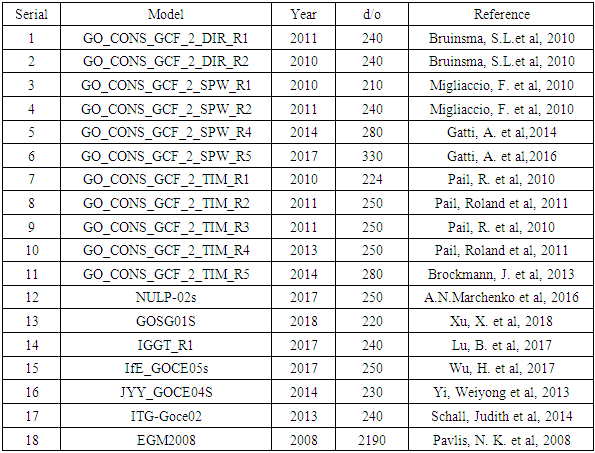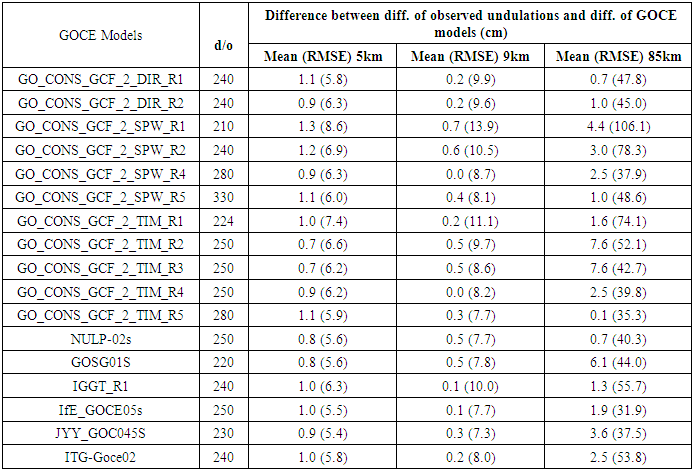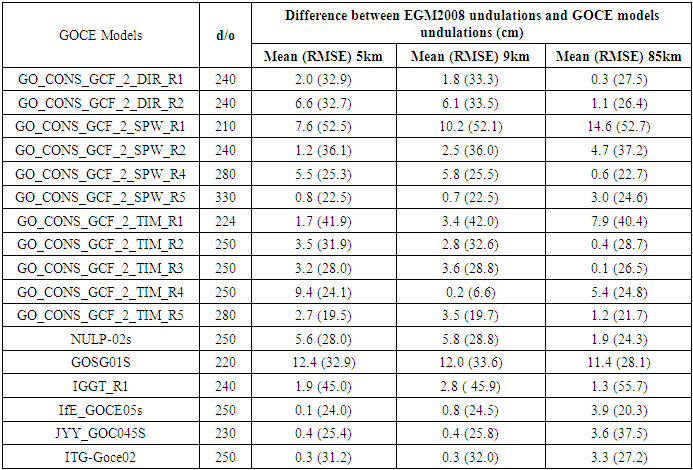-
Paper Information
- Paper Submission
-
Journal Information
- About This Journal
- Editorial Board
- Current Issue
- Archive
- Author Guidelines
- Contact Us
American Journal of Geographic Information System
p-ISSN: 2163-1131 e-ISSN: 2163-114X
2019; 8(3): 131-140
doi:10.5923/j.ajgis.20190803.03

Evaluation of GOCE Satellite only Models along the River Nile
Abdallah A. Saad, Mona S. El-Sayed
Surveying Engineering Department, Faculty of Engineering- Shoubra, Benha University, Egypt
Correspondence to: Mona S. El-Sayed, Surveying Engineering Department, Faculty of Engineering- Shoubra, Benha University, Egypt.
| Email: |  |
Copyright © 2019 The Author(s). Published by Scientific & Academic Publishing.
This work is licensed under the Creative Commons Attribution International License (CC BY).
http://creativecommons.org/licenses/by/4.0/

Geoid is the equipotential surface of earth’s gravity field, which partially coincides with the mean sea level. The external Earth’s gravity field is represented by Global Gravitational Model (GGM) which is consisted of globally and homogeneously distributed terrestrial and satellite gravity observations. GOCE is one of the satellite missions that have been used to determine the gravity field of the earth. It mainly represents the long wavelength components of the gravity field which can be evaluated externally by using terrestrial data such as GPS levelling. 17 GOCE models are evaluated against EGM2008 and 134 GPS levelling stations. The RMSE of the undulation differences (N (GOCE models) – N (GPS levelling)) are considered the usual method for measuring the accuracy of the models. Another technique is used for evaluation, using the successive differences of the observed undulations against their corresponding values from the GOCE models. In this study, different types of GOCE models with different degree and order are examined against observed undulations and EGM2008 at three different distances. The first distance between the points is about 5 km which is the approximate distance between every two successive data points. The second distance is about 9 km which corresponds with the EGM2008 resolution, and the third case is about 85 km every two successive data points which is the average resolution of the assessed GOCE models. Numerical results showed that some of GOCE models gave comparable results with EGM2008 especially at level of undulation differences.
Keywords: GPS/Levelling, Geoid Undulation, GOCE Models, EGM2008, Rate of Change, Undulation Acceleration
Cite this paper: Abdallah A. Saad, Mona S. El-Sayed, Evaluation of GOCE Satellite only Models along the River Nile, American Journal of Geographic Information System, Vol. 8 No. 3, 2019, pp. 131-140. doi: 10.5923/j.ajgis.20190803.03.
Article Outline
1. Introduction
- One of the principal scientific objectives of GOCE satellite mission was to recover the global gravity field with an expected accuracy of about 1–2 cm (in terms of geoid) or 1 mGal (in terms of gravity) at the level of a spectral resolution of about degree 200 in terms of spherical harmonics, which corresponds to about 100 km at the equator [1-3]. GOCE is the first satellite mission to measure gravitational gradients directly using a high-precision electrostatic gravity gradiometer by the differential acceleration technique [4], which was used to recover the medium-to-higher frequency signal of the gravitational field. The on-board GPS receiver provides the Satellite-to-Satellite Tracking (SST) data, which were used to determine the precise kinematic orbit with a cm-level accuracy [5], and consequently to recover the long-wavelength part of the gravity field. Generally, there are several different numerical techniques applied to recover the global gravitational model (GGM) by processing the GOCE Satellite Gravity Gradient (SGG) observables. Probably the most commonly used techniques are: the direct approach (DIR), the time-wise approach (TIM), and the space-wise approach (SPW) corresponding to the three types of models which are determined by the GOCE High Level Processing Facility (HPF) [6-8]. In this study, the global geoid models produced by GOCE satellite mission are investigated: 17 GOCE models are assessed using 134 GPS levelling stations along the Nile River to evaluate the models’ performance in relation to each other on one hand, as well as, assessing their absolute agreement with terrestrial data and EGM2008 on the other hand. The following are some descriptions for GOCE models;Models of the GOCE High-level Processing Facility (HPF) by ESA • Direct (DIR) approach (maximum degree and order 300) - 5 data levels – Released data 01/11/2009 – 20/10/2013 - A priori data (EIGEN-5C (DIR1), ITG-Grace2010s (DIR2)) - Complementary data from LAGEOS + GRACE for lower degrees and orders • Time-wise (TIM) approach (maximum degree and order 280) - 5 data levels – Released data 01/11/2009 – 20/10/2013 - GOCE-only models • Space-wise (SPW) approach (maximum degree and order 280) - 3 data levels – Released data 11/2009 – 31/7/2012 - GOCE-only models - A priori high-resolution models (e.g. EGM2008) used for variance and covariance modellingOther GOCE-only models • ITG-Goce02 (maximum degree and order 240) - Released data 01/11/2009 – 31/6/2010 • JYY_GOCE02S (maximum degree and order 230) - Released data 01/11/2009 – 31/08/2012 • JYY_GOCE04S (maximum degree and order 230) - Released data 01/11/2009 – 19/10/2013 Combined GOCE+GRACE models • EIGEN-6S2 (maximum degree and order 260) - Released data GOCE 01/11/2009–24/5/2013, GRACE 2/2003–9/2012, LAGEOS 1985–2010 • GOCO01S, GOCO02S, GOCO03S and GOCO05S (maximum degree and order 280) - Released data GOCE 01/11/2009 –20/10/2013 (TIM5), GRACE 2/2003 –12/2013 (ITSG-Grace2014s) • GOGRA02S and GOGRA04S (maximum degree and order 230) - Released data GOCE 01/11/2009 –19/10/2013, GRACE 8/2002–8/2009The EGM2008 model is complete to spherical harmonic degree and order 2159, and contains additional coefficients extending to degree 2190 [9]. Also, it is supplied with a conversion model complete to degree and order 2160 for converting height anomalies to geoid undulations. It represents the highest resolution to date of 5 * 5 arc minute (9km *9km) [10,11]. EGM2008 have been evaluated in different part of the world by several authors [12-14].
2. Data Used (Observed Undulations – EGM2008 – 17 GOCE Models)
- The study area extends from Assiut (Lat. 27° N) to Damietta (Lat. 31° N) along the Nile River. 134 fixed stations were established every about 5 km apart, covering total distance of 600 km, Figure 1.
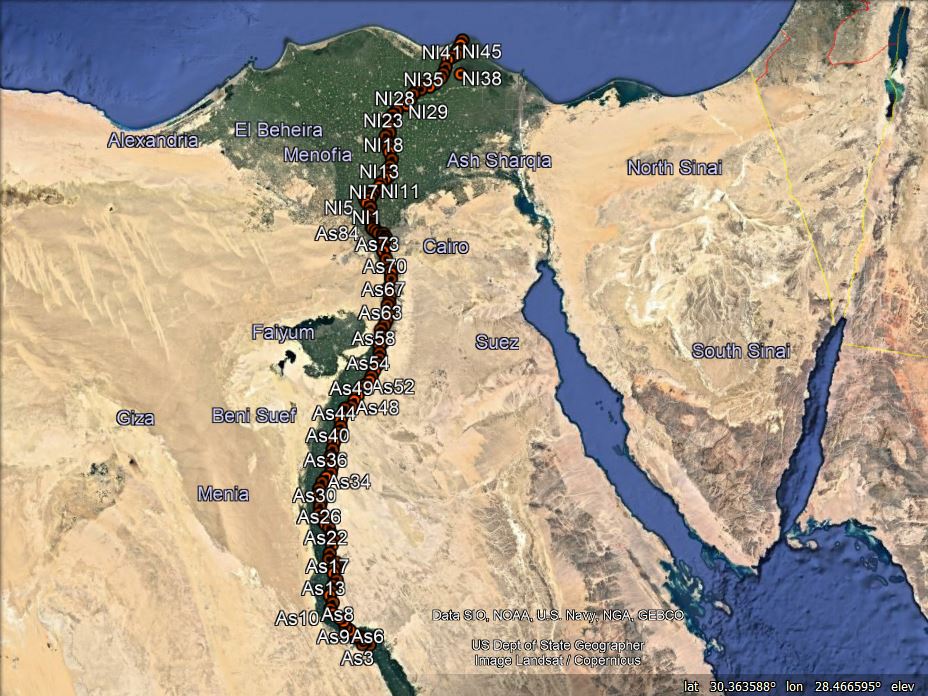 | Figure 1. The available points in the study area |
|
3. Investigating the Performance of the Used 17 GOCE Models against the GPS Levelling and EGM2008 over the Test Area
- The observed geoid undulations at the fixed stations are obtained from the well-known relation:Ni = hi - Hi where N is the geoid undulation, h is the ellipsoidal height obtained from GPS and H is the orthometric height obtained using spirit levelling. Using the latitude and the longitude of the observed stations, the corresponding geoid undulation values from EGM2008 and the 17 GOCE models are obtained from the websitehttp//icgem.gfz-postdam.de/ICGEM/ICGEM.html.So, the data that will be manipulated are the observed geoid undulations at the 134 stations and their corresponding values from EGM2008 and 17 used GOCE models.
3.1. Methodology and Results
- Measuring the performance of the used 17 GOCE models over the test area will be examined at 3 levels of station spacing, 5, 9, 85 km. Station every five km to examine the models at the level of observed stations spacing. Nine km is to examine the models at the level of EGM2008 resolution. Eighty-five km is to examine the models at the level of the average resolution of the used GOCE models. The observed undulation file is reduced once to 61 values and once more to 7 values out of 134 original values corresponding to about 9 and 85km respectively. The other files of EGM2008 and GOCE models are also reduced in the same way to be in correspondence with the reduced observation file. In most of the assessment works, a comparison between the model undulations against the observed undulations is the common way of assessment. This way produces a large mean and RMSE values of the resulting differences. Table 2 is extracted from [10] to show the usual way of comparison for the used GOCE models and EGM2008. The table contains RMSE of the differences between GPS levelling and the mentioned models for different data sets in different places;
|
 | Figure 2. Observed undulation against EGM2008 undulations |
3.1.1. EGM2008 Undulations against Observed Undulations in the Cases of 5, 9, 85 km Station Separations
- The differences between the observed undulations and their EFM2008 corresponding values are computed and the statistics of those differences are obtained and illustrated in Table 3 and Figure 3.
|
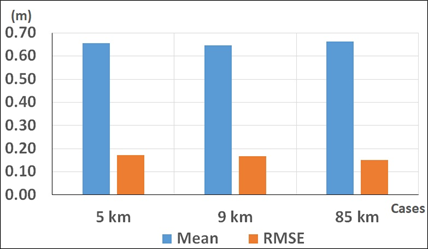 | Figure 3. The mean and RMSE of the differences between observed and EGM2008 undulations in the three cases |
3.1.2. EGM2008 Differences against Observed Differences in Cases of 5, 9, 85 km Station Separations
- Undulations successive differences are computed for both observed and EGM2008 undulations. The differences between the observed successive differences and their EGM2008 corresponding values are obtained and illustrated in Table 4 and Figure 4.
|
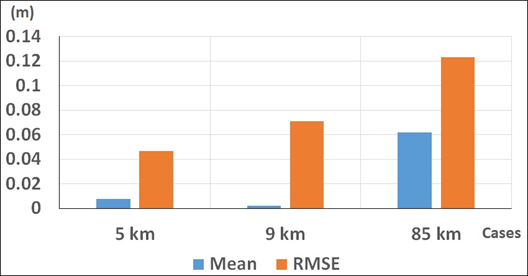 | Figure 4. The mean and RMSE of the differences between observed and EGM2008 undulation differences in the three cases |
3.1.3. GOCE Models Undulations against Observed Undulations in Cases of 5, 9, 85 km Station Separations
- The differences between the undulations from the 17 GOCE models and the observed undulations are computed, Table 5 and Figures 5, 6, 7 illustrate the statistics of those differences;
|
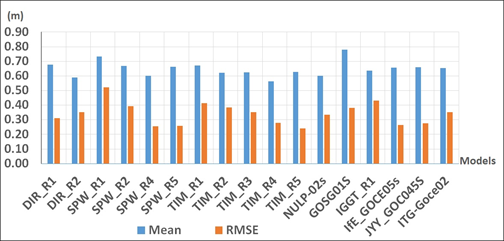 | Figure 5. The mean and RMSE of the differences between observed and GOCE models undulations, case of 5 km |
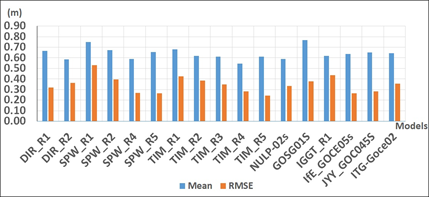 | Figure 6. The mean and RMSE of the differences between observed and GOCE models undulations, case of 9 km |
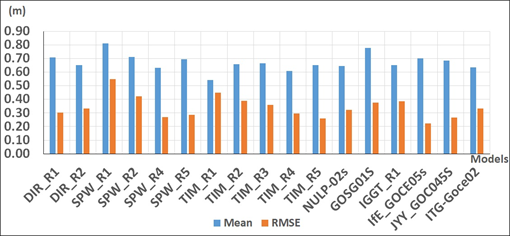 | Figure 7. The mean and RMSE of the differences between observed and GOCE models undulations, case of 85 km |
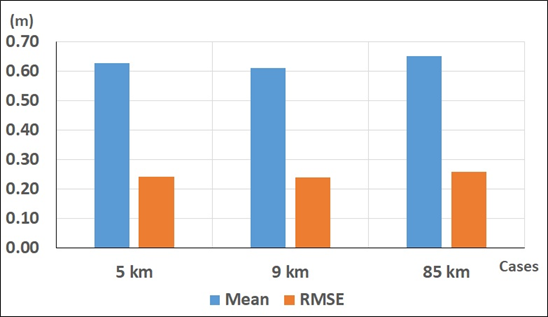 | Figure 8. The mean and RMSE of the differences between observed and TIM_R5 GOCE model undulations, cases of 5, 9, and 85km |
3.1.4. Observed Undulation Differences against the Corresponding Values from GOCE Models in Case of 5, 9, 85 Km Station Separations
- The differences between every two successive points in every GOCE model are computed. The differences between the observation differences and GOCE models’ differences are obtained; the next table and three figures illustrate the statistics of these differences.
|
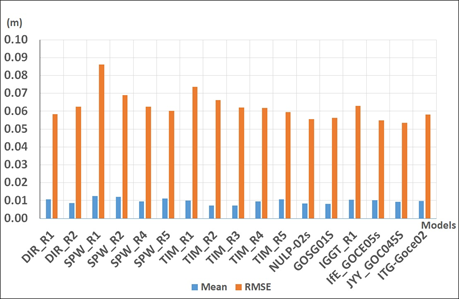 | Figure 9. The mean and RMSE of the differences between observed and GOCE models undulation differences, case of 5 km |
 | Figure 10. The mean and RMSE of the differences between observed and GOCE models undulation differences, case of 9 km |
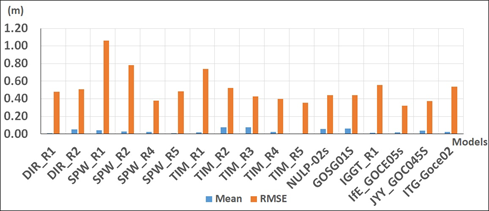 | Figure 11. The mean and RMSE of the differences between observed and GOCE models undulation differences, case of 85 km |
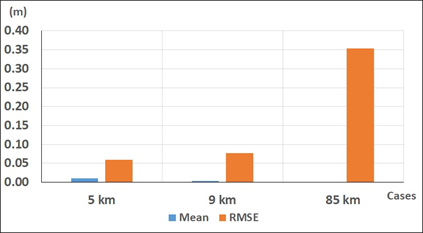 | Figure 12. The mean and RMSE of the differences between observed and TIM_R5 GOCE model undulation differences, cases of 5, 9, and 85 km |
3.1.5. EGM2008 Undulations against GOCE Models Undulations in the Case of 5, 9, 85 km Station Separations
- The differences between the undulation values from EGM2008 and from GOCE models are computed and their statistics are shown as follows;
|
 | Figure 13. The mean and RMSE of the differences between EGM2008 and GOCE models undulations in the case of 5 km |
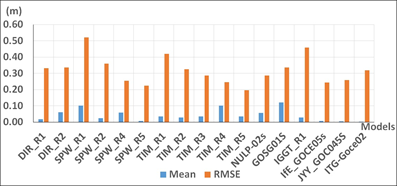 | Figure 14. The mean and RMSE of the differences between EGM2008 and GOCE models undulations, case of 9 km |
 | Figure 15. The mean and RMSE of the differences between EGM2008 and GOCE models undulations, case of 85 km |
 | Figure 16. The mean and RMSE of the differences between EGM2008 and TIM_R5 GOCE model undulations, cases of 5, 9, and 85km |
3.1.6. EGM2008 Undulation Differences against the Corresponding Values from GOCE Models in Cases of 5, 9, 85 km Station Separations
- The differences between EGM2008 undulation differences and GOCE model’s undulation differences are computed; the following table and three figures illustrate the statistics of these differences.
|
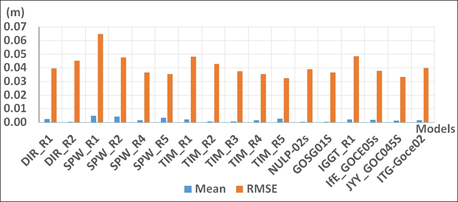 | Figure 17. The mean and RMSE of the differences between EGM2008 and GOCE models undulation differences, case of 5 km |
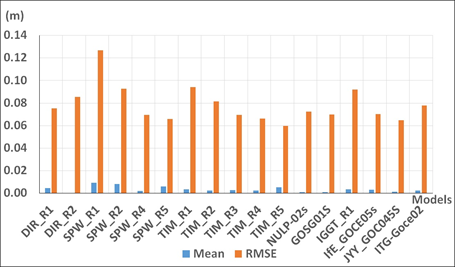 | Figure 18. The mean and RMSE of the differences between EGM2008 and GOCE models undulation differences, case of 9 km |
 | Figure 19. The mean and RMSE of the differences between EGM2008 and GOCE models undulation differences, case of 85 km |
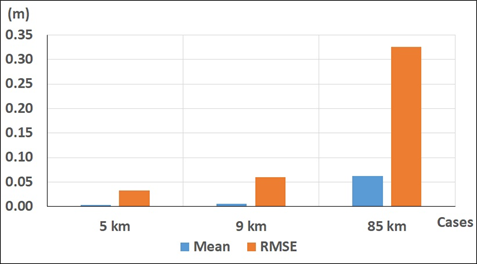 | Figure 20. The mean and RMSE of the differences between EGM2008 and TIM_R5 GOCE model undulation differences, cases of 5, 9, and 85km |
4. Conclusions
- Using the undulation differences in the comparisons (evaluation) showed much better consistency than using the comparisons of the undulation themselves. The differences and RMSE values of the first case are much smaller than their corresponding values of the second case. So, using undulation differences is much readable than using the full undulations. Then the adopted differences can be converted to full values using one trusted full undulation. The used GOCE models can be divided into subgroups; 2 DIR, 4 SPW, 5 TIM, and 6 others. The results inside every group are improved with the production year of the model. DIR model of 2011 is better than DIR model of 2010. The same for the two groups of 4 models of SPW and 5 models of TIM. The models of d/o 210, 220, and 224 are always among the worst models. The best models always include models of d/o 280 and 330.The results of the cases 5, 9 km station separation are close to each other’s with respect to most of the used models. Seven undulations, six differences, will be considered insufficient data in the case of 85 km. TIM_R5 is always among the best models compared to the observed data and EGM2008. It will be taken as a representative to the used GOCE models. Overall the used 134 points, and in the comparison with EGM2008 undulations, this model has 2.7 and 19.5cm as mean and RMSE respectively. In the comparison with EGM2008 undulation differences, this model has 0.3 and 3.3cm as mean and RMSE respectively.In comparing TIM_R5 undulations with the observed undulations, it gave 62.8 and 24.1cm for the mean and RMSE respectively. In comparing the undulation differences with the observed undulation differences, it gave 1.1 and 5.9cm as mean and RMSE respectively. To sum up, in the comparison of EGM2008 undulations with the observed undulations, the mean differences and RMSE were 65 and 16cm respectively. And in the case of comparing EGM2008 undulation differences with their corresponding observed values, the mean and RMSE were 0.8 and 4.7cm respectively. Recalling that TIM_R5, which is adopted here to represent GOCE models because it is one of the best models. It is a satellite only model with d/o 280 and it is produced in the year 2014 and it is produced from 4 yeas GOCE released data 01/11/2009 – 20/10/2013.Finally, and based on the results illustrated in the tables and figures, it can be concluded that a GOCE satellite only model and EGM2008 gave RMSE 16 and 24 cm respectively compared to the observed undulations. And in the case of comparing undulation differences from both models against the observed undulation differences, they gave RMSE 4.7 and 5.9 cm respectively. This is assured by comparing the undulations from that GOCE model against EGM2008 undulations where the mean (RMSE) were 2.7 (16.5) cm. The mean (RMSE), in the case of comparing GOCE model undulation differences against EGM2008 undulation differences, were 0.3 (3.3) cm. GOCE satellite only models are comparable to EGM2008 especially at the level of undulation differences. Undulation differences from both EGM2008 and some GOCE satellite only models can be used instead of the observed undulation differences in many applications.
 Abstract
Abstract Reference
Reference Full-Text PDF
Full-Text PDF Full-text HTML
Full-text HTML